How to unclog a toilet with a cable
When using a plumbing cable when the toilet is clogged, the following instructions must be followed:
- The floor in the toilet must be covered with plastic foil. Protect hands with rubber gloves. The device is removed from the package and inspected for integrity. Identify the cause of the blockage and its location. Select suitable attachments.
- The cable must be shoved into the toilet through the drain hole. You do not need to dissolve it to its full length right away. The device is unwound gradually, overcoming difficult places and pipe bends. The remainder is kept twisted into a ring in the hand where the handle is. To push the tool through the pipes, the handle is rotated in the desired direction and gently push the end of the device into the depth.
- When the tip rests against the debris plug, use the handle to make a few jolts, trying to break through the jam. This way you can clear the blockage with a harpoon-tipped parting. If there are hooks at the end, then they need to pick up the blockage and pull it out.
- When the stagnant water begins to decrease, the elimination of the blockage can be considered complete. It remains only to check the system performance. When flushing, the water in the toilet should be swirled into a funnel.
Comment! To soften the blockage, you can empty the tank and supply hot tap water to the toilet during the cleaning process.
How to independently clean the toilet or sink (the same principle) using a cable, you can watch the video:
Blockage prevention
Usually, once worn out with the problem of toilet clogging, the owners of residential premises become more attentive. In order not to have to think about how to clean the toilet if it is clogged, it is necessary to take measures so that the blockage does not occur:
- use the toilet for its intended purpose;
- prevent the toilet bowl from filling up with household or construction waste;
- make sure that poorly soluble foreign objects do not fall into the toilet;
- do not pour the remnants of fatty foods there, since fat is difficult to dissolve, settles on pipes and contributes to the further clogging process;
- supervise small children so that they do not let small toys down the toilet;
- carry out preventive work with the help of special chemical reagents once a month;
- pipes in the bathroom and in the kitchen require the same competent and attentive approach.
Chemicals
People who do not want to mechanically clean the blockages use chemicals.
Liquid
Liquid chemicals are used to clean plastic drain pipes. They are characterized by a gentle action that does not damage the plastic surface. The most effective liquid products include "Mister Muscle" with a slight ammonia smell and "Tiret", which does not smell.
Powders
Powder formulations are also available to help clear blockages.
Effective powder detergents include "Komet". It is a versatile powder used not only for cleaning sewers, but also for washing household appliances. To get rid of the blockage, "Komet" is poured into the drain and filled with hot water.
Acidic
To remove serious blockages, due to which the liquid has completely stopped draining, acidic agents will help. They are able to eliminate food debris as well as traces of grease and dirt on pipes.
Alkaline
Alkaline products are ideal for cleaning kitchen sinks. They effectively fight grease residues that may remain in the drain after washing dirty dishes or pots.
When choosing alkaline products, you should pay attention to "Domestos" and "Whiteness"
Hot water with soda
A simple and healthy alternative to chemicals is regular hot water with soda. The calculation of the composition is as follows: 500 grams of soda per 1 liter of boiling water. Soda is poured into a bucket of boiling water and immediately thrown into the drain hole. The solution should work within 10-15 minutes.
 A bucket of water will take about half a packet of baking soda.
A bucket of water will take about half a packet of baking soda.
To enhance the effect, you can use baking soda and vinegar. In this case soda is poured directly into the drain hole. Then vinegar is poured into it and boiling water is added sharply. The reaction between the baking soda and vinegar will produce carbon dioxide, which will eat away at the deposits in the pipe.
 Soda effectively dissolves various organic impurities and fats.
Soda effectively dissolves various organic impurities and fats.
In addition to this method, there are many more folk remedies for cleaning pipes.
Advantages and disadvantages of cleaning the toilet with a cable
One of the main advantages of a toilet bowl cleaning cable is its ease of use. It is enough just to lower the device into the drain hole and rotate it. Work can be carried out at great depths of pipes, up to 70 m. Thanks to special nozzles on the tip, the blockage is easy to clean. It lends itself to ejection and breaks down quickly. Another positive feature of the device is flexibility, the blockage can be cleaned in pipes of different configurations.
Of the shortcomings, plumbers and homeowners note only 3 points:
Rough handling can damage the plastic pipe walls.
The process of breaking through the trash plug can take a long time (10-40 minutes). It is not always possible to clean the blockage from 1 time.
After use, the device must be cleaned to remove dirt residues .. Note! Dried tools must be lubricated with machine oil.
This will extend its life.
Comment! The dried tool must be lubricated with machine oil. This will extend its life.
How to clean a siphon
If the blockage is local, then most often it is located in the siphon.
Do not forget to substitute the container before unscrewing the siphon
Instructions:
- We unscrew the plastic nut that holds the tube in the drain siphon.
- We pull out the siphon and lower it into a basin for further cleaning (we remove all the dirt with a hand or a brush).
- Pour a soda-vinegar mixture into the pipe connected to the sewer (as described above).
- After the end of the reaction, pour in a glass of vinegar.
- Repeat the addition of vinegar until the hissing stops.
- After 15–20 minutes, pour 2-3 liters of hot water into the pipe (not boiling water!).
- We fasten the siphon in place, tighten the plastic nut.
Steps 3-6 are necessary if there is a plug in the pipe. If cleaning the siphon is a regular event not caused by water obstruction, then you do not need to use a soda-vinegar mixture.
We break through the drain with the help of chemicals
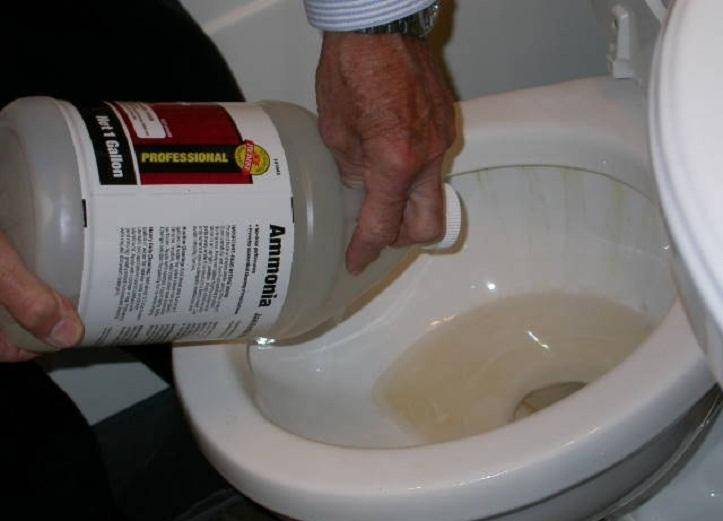
If you like to flush food leftovers, grease from pans and other waste into the toilet, you should be prepared for the fact that sooner or later a fatty blockage will form in the drain of your toilet. Little by little, the fat settles on the inner sides of the pipes. Over and over again, with subsequent flushes of liquids containing fat, its layer grows more and more, until, at one point, it completely covers the cavity of the pipe. Let's say that the toilet bowl clogged up in exactly this way, how can you clean such a blockage yourself without a plunger?
Here special tools for cleaning the toilet will come to the rescue. Some of them are able to break down and dissolve not only fats in themselves. They can soften any organic matter, even human hair, without harming the ceramics or plastic from which most of today's sewer pipes are made.
How is the elimination of blockages carried out using toilet cleaners? Regardless of which of the products you settled on, be it Domestos, Tiret, AntiZazor or Mole (there are a great many of them now in specialized stores), each of them has its own instructions for use.Most likely, you will be prompted to add so much liquid of the product to the toilet drain and wait. Sometimes a rather long period of time is allotted for the process - up to 24 hours.
Therefore, it is best to "fill up" the toilet bowl cleaner into the system in the evening. If, waking up in the morning, you find that the water is gone, and when you flush on duty, the liquid goes into the drain perfectly, congratulations! You managed to clear the blockage of the toilet with only one tool, which, to be honest, rarely works. Most often, housewives do not stand up to expectations, or they do not wait for a positive result and call plumbers.
Special valve
To be honest, we do not even know what it is called and whether this thing can be purchased in stores. A special sticker is attached to the toilet, then the bowl is filled with water to the top. The sticker lifts up and creates pressure - so the clogged toilet is cleaned. Only one thing is interesting: what if this sticker does not hold up?
If none of these methods has helped to cope with a clogged toilet, then most likely you will still have to call specialists. We will not talk about the fact that it is better to avoid problems. Anything can happen.
Tips from an experienced plumber: how to choose the right toilet
Blockage prevention
To prevent clogging of the toilet bowl through your own fault, the following rules must be observed:
- if there are small children in the house, you need to be careful not to throw various objects into the toilet. Toddlers usually do this out of curiosity;
- fat must not be drained into the sewer, and fatty food debris must not be thrown away. This waste sticks to the inner curve of the toilet bowl and forms a tight plug over time; you need to clean the toilet weekly using a regular plunger. Once a month, it is worth using chemical agents to dissolve blockages;
- do not throw toilet paper and hygiene products into the toilet. It is better to install a small bin for this type of waste in the toilet;
- if there are pets in the apartment, the filler from their tray must not be flushed down the drain, but thrown into the trash bags. To avoid the appearance of an unpleasant odor, the garbage is immediately taken out of the house.
- if old pipes are installed in the toilet and bathroom, it is worthwhile to attend to their replacement. This will help you avoid a lot of problems and feel more confident.
- when the toilet is being renovated, the toilet must be closed with a lid. This will prevent small and large construction debris from getting inside it.
Mechanical elimination methods at home
There are three mechanical ways to clear blockages.
Ventuz
Many plumbers use plungers to remove blockages from sewer pipes. The main advantage of this tool is considered its ease of use. Even a person who has never used a plunger can handle pipe cleaning.
To clean it, you need to draw a little water into the sink, and then press the plunger to the drain hole. Then 4-6 progressive actions are done, and at the end of the procedure it is torn off the drain. The steps are repeated 5-6 times until the water starts to drain well.
Plumbing cable
To remove a severe blockage, it is better to use a plumbing cable. This device is suitable for deep cleaning of sewer pipes.
Before breaking through the blockage, you need to place the plumbing cable inside the drain. The fixture is then slowly rotated clockwise and gradually pulled downward to push the plug.
Bottle use
You can even clean the blockage with improvised means that you can do yourself. For example, some people use a regular plastic bottle for this. First, spiral marks are made on it, along which it will be cut. Then small incisions are made on the spirals at an angle of 40-50 degrees.After that, the bottle is pushed into the tube and gradually removed along with the debris adhering to it.
We break through the blockage with a plunger
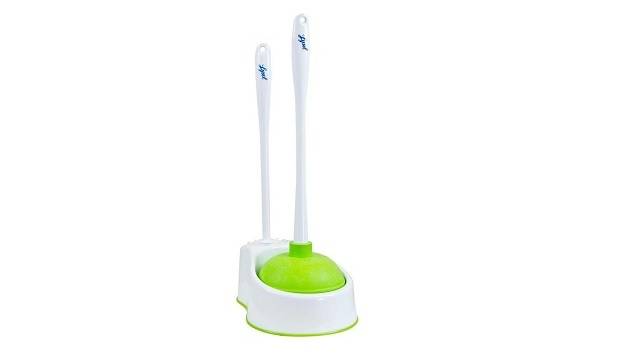
What to do if the toilet is clogged and the water flatly refuses to leave it or does it very slowly? First of all, open the tap in the bathroom or shower and look. If the water runs out normally, the blockage is organized in the toilet itself.
For punching, we will use the usual plunger, which should be present in everyone's household. In appearance, this tool resembles a hefty suction cup. If you put it to the surface with the lower rubber rim and press on the handle, pressure will be created inside the rubber part of the plunger, which will tend to break out from under the pressed rim. This is what we will use.
Having placed the rim of the rubber part of the suction cup of the plunger over the hole where the sewage goes so that its edges are pressed as tightly as possible to the drain, we begin to make up and down movements. It is not necessary to tear off the plunger itself from the hole every time. The range of motion should not exceed the tension of the rubber part.
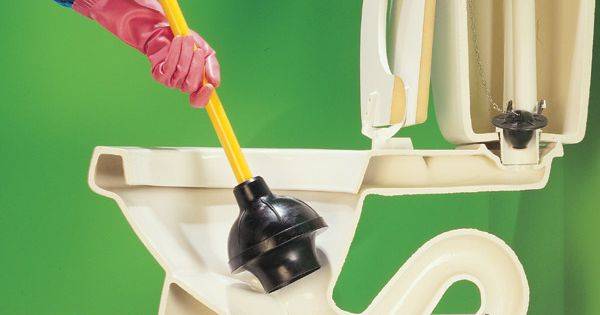
The pressure created inside the drain pipe will gradually push the blockage towards the main sewer, or vice versa, suck it out. In any case, if the water began to leave, the job is done.
If the blockage is organized somewhere in the main pipe further than the toilet bowl, as evidenced by the water not leaving the bathtub, you can try to influence the blockage through the drain of the bathroom itself. The plunger adheres to the surface of the bathtub more tightly and it will be easier to break through the blockage. We press, we swing, everything, the water went into the hole with a squelching sound, the blockage is removed.
If not, you will have to act in other ways. And since it was not possible to pierce the toilet bowl without a cable and without chemistry by pressure alone, we will try them one by one.
How to clear a blockage in a kitchen sink at home in a variety of ways
Before you start removing the blockage in the sink, you need to understand the reasons for its appearance. The choice of a way to eliminate it will depend on the sources of formation of the blocking plug. The main causes of pipe clogging are:
- Poor plumbing condition. Over time, it corrodes and degrades. Rust builds up on the pipe walls, restricting the drainage passage. Residues of food, edible fat and other household waste, settling on corroded areas, completely block the pipes, forming a blockage;
- Deposits of salts of heavy metals in running water. Heavy build-ups on the pipe walls, accumulated under the influence of hard water, are compacted and subsequently form blockages that impede the passage of water;
- Accumulation of grease, food debris, hair and other household waste. Small particles of food and grease after washing dishes, hair and foreign objects that accidentally get into the water pipe become a frequent cause of clogging of pipes in the kitchen sink;
- The specific design of the sink, affecting the formation of a blockage in the siphon. The clogging of dirt and grease often occurs in the siphon of the sink due to the peculiarities of its structure. Small diameter, curved or flat design, tightness - affect their gradual clogging with food waste during operation.
Knowing the reasons that caused the formation of a plug in the water supply system, it is necessary to choose the appropriate method of how to clear the blockage in the kitchen sink at home with improvised means.
Locating the plug
Before, how to remove the blockage in the toilet, determine the place where it formed, and for this you need to inspect the sewer riser available in the bathroom and in the kitchen. It should be remembered that the problem is common if the apartment is located in an apartment building.
In a private household, if you have to remove the clogging of the toilet with your own hands, you need to look for the reason outside the building on the street in the place where the pipe is directed to the cesspool, or at the site of connecting the local sewerage system to the citywide system.
The fact that the blockage is common is evidenced by the liquid that cannot be drained from the bathroom. In a situation where, with the simultaneous use of a drain in the kitchen sink and in the toilet, the liquid flows unhindered, the cause of the problem is in a different place - where there is stagnation.
The reasons for the blockage
Before you clean the sink from the blockage at home, it is important to establish the cause of the blockage. It can be corrosion of metal pipes
In metal devices, mineral build-up and rust gradually form. Only an expert can handle the cleaning of such pipes. However, many houses now have modern pipes made of plastic, which does not corrode. Therefore, they will not face such a problem.
The clogging can be caused by the wear of old pipes or other equipment. In this case, replacement of the siphon, wiring, riser and other devices is required. Sometimes a blockage appears due to the accumulation of small solid particles of flowing water inside the pipeline. This means that you have too contaminated tap water, which requires additional treatment. See here what to do if dirty or rusty water flows.
In addition, a blockage is formed due to the ingress of debris and due to the grease plug that forms when washing dishes. Various small debris gets into the drain, including the remains of food and soap or detergents, threads, hair, animal hair and other elements.
This is the most common reason for a clogged bathroom or kitchen sink. In this case, we can flush the drain and pipe with our own hands. Let's take a closer look at how to clear a blockage in a kitchen or bathroom sink.

The toilet is clogged: how to clean it yourself at home?
The toilet in the house is one of the main premises. If the guests may not look into the room, then they will definitely visit the toilet.
What will be the opinion of the hostess at the sight of dirt, rust and limestone deposits in the toilet? The washroom must be kept clean at all times. If the closet is clogged, it will not be difficult to clear the clog in the toilet.
So, the toilet is clogged. How to clean it yourself at home?
If water in other rooms flows freely into the drain, then the toilet is clogged. In this case, you can deal with the problem yourself.
You can eliminate the blockage in the toilet with the help of improvised means:
- Ventuz. Its diameter must be larger than the diameter of the drain hole. You need to close the hole with the tip of the device and make several strong hydraulic shocks.
- Plastic bottle. If the plunger is not at hand or its diameter is not suitable for manipulation, you can clear the blockage in the toilet with a plastic bottle.
The bottom of the bottle needs to be cut off and the cap screwed on. The device should be inserted into the hole of the toilet bowl until it stops, then removed with a sharp movement. You will have to repeat the action several times.
Plumbing cable. To deal with deep blockages, use a special steel cable with a spiral or weight attachment. The end of the cable must be lowered into the hole until it stops, then rotating the cable, push it, it must break through the plug.
What to do if mechanical methods failed to remove the blockage? Then, to fix the problem, you should use a toilet blockage remedy.
- Household chemicals. A wide range of household chemicals is presented in hardware stores. Which remedy is better to use? According to consumer reviews, Tiret, Domestos, Mister Muscle are named the best remedies.
To quickly remove the blockage, you can use the "Mole", its price is lower than imported funds. "Mole" is a solution of inorganic salts that effectively removes plaque and other contaminants.
Pour 200 ml of "Mole" into the drain hole and leave for a couple of hours, and then rinse with water.
Folk remedies
If there are no household chemicals in the house did not appear, folk remedies will come to the rescue.
The toilet is clogged: how to clean it yourself at home? Is the toilet clogged in the house? This is not a reason to panic, you can deal with the problem yourself at home. How can you clean the toilet yourself?
Causes of pipe clogging
Water pipes in old buildings (standard wiring in an apartment) are steel communications of small diameter (15 mm).
The specificity of such communications eventually leads to the accumulation of impurities on the inner wall. Gradually, the clearance in the pipe decreases, the water pressure at the supply drops. This does not happen overnight and may not be immediately noticed by the residents. The X hour comes when a weak water supply begins to interfere with the normal operation of the washing machine, boiler, gas water heater.
Sometimes the water supply in a single apartment suddenly stops completely.
Reasons for a clogged water pipe:
- Mechanical filling of the internal lumen of the water supply system with sand suspensions in the supplied water. The reason for the blockage is the inadequate quality of the tap water and its insufficient purification.
- Natural aging of steel water pipelines, their corrosion. In the process of rusting the inner part of the pipes, iron salts are formed, which fill the inner lumen of the communications with a loose mass. The situation is aggravated by the small diameter of the intra-apartment plumbing.
- Accumulation of salts contained in hard tap water on the pipe walls. Natural salts dissolved in water, for various reasons, can precipitate and linger on the walls of water supply lines. The accumulation process in this case is slow, but over decades, such deposits can completely shut off the water supply.
- Breakage of the valve, mixer.
- The weakening of the water flow at the bends of the water pipes, in the wiring places creates favorable conditions for the deposition of contaminants on the fittings.
- The coarse filter is dirty.
Locations typical of blockages:
- Water filters. Filters for mechanical purification of tap water are currently installed by many owners. This is often the reason for the lack of water supply to the apartment.
- Filter on the water meter.
- Valves. The valve acts as a natural obstacle to the flow of water. Salt deposits on the tap that shut off the water can be the reason for the weakening of the pressure or the lack of water in the apartment.
- Mixers. On the working surfaces of the mixer, both salts dissolved in hard water and rust from pipes, small particles of water contaminants that have seeped through the filter are deposited.
- Water pipe bends. The distribution of the water supply around the house assumes the presence of pipe turns. In the place where the water pipe makes a sharp bend (90 degrees), the deposit contaminating the pipe settles in a larger amount than in straight sections. Elbows, adapters, tees are clogged as often as valves, filters on meters.
Blockage prevention
Various preventive measures will help prevent the occurrence of sewage blockages, which include:
- the use of plumbing is strictly for its intended purpose, excluding the ingress of foreign objects into it;
- cleaning pipes using specialized chemicals;
- weekly you need to carry out preventive cleaning - using a plunger or boiling water.
Using the presented methods, you can independently and quickly cope with simple blockages of the sewer system. However, in difficult situations, turning to professionals still makes sense. By regularly taking care of the functionality of your plumbing, by preventing blockages, you can avoid problems requiring the adoption of the measures described above.
Chemical methods of pipe cleaning
When thinking about how to clean a toilet bowl from a blockage, the first thing that comes to mind is the idea of using special solutions.The use of chemical reagents makes pipe cleaning convenient and quick. They are able to remove blockages in just a few minutes. The action of such funds as "Mole", "Domestos", "Mister Muscle" and others is based on a high concentration of acids or alkalis. That is, chemical reagents simply corrode the deposits in the pipe.
 Acid-based products do not dissolve blockages, but they can damage pipes great.
Acid-based products do not dissolve blockages, but they can damage pipes great.
However, they also damage pipes. Due to the frequent use of such funds, microcracks appear in the pipes, due to which blockages will form more over time. Also, when using these funds, it is necessary to strictly follow the safety precautions and instructions for use. In particular, use gloves and, if possible, safety goggles. Otherwise, you can get chemical burns.
 Acids that dissolve organic matter do not dissolve polyethylene, and it is plastic bags that cause half of the blockages.
Acids that dissolve organic matter do not dissolve polyethylene, and it is plastic bags that cause half of the blockages.
These agents help to clean pipes from blockages with deposits. They will not be able to remove a large object from the sewer, for example, a rag.
What to do next
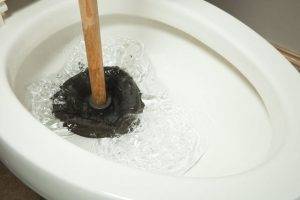 Then the way is chosen, in which the clogged toilet will break through. The following methods are available:
Then the way is chosen, in which the clogged toilet will break through. The following methods are available:
- mechanical - with a cable and a pump;
- chemical - with the help of special means to eliminate pipe blockages;
- manual using a plunger.
Before starting work, all households should be interviewed - perhaps they know which particular object got into the toilet and clogged the sewer. If it is a diaper or a rag, then they can be easily removed using a bent wire or even by hand, after putting on gloves.
If the cause of the blockage is unknown, but the water gradually decreases, a plunger should be used. There is no need to randomly mess up the stagnant water in the toilet with this tool. So that the efforts are not in vain, you should use it like this:
- First, plug both drains in the bathroom with plugs.
- Plunge the plunger into the toilet. It should be half covered with water. If there is less water, you need to top it up.
- Then the plunger is removed, immersed again and pressed so that a vacuum is formed under it - this will be felt.
- After that, they make several vigorous up and down movements.
- If nothing happened after the first run, the manipulation is repeated. For the third or fourth time, the plug should push out into the sewer and the water begins to subside. If this does not happen, you need to apply other methods.
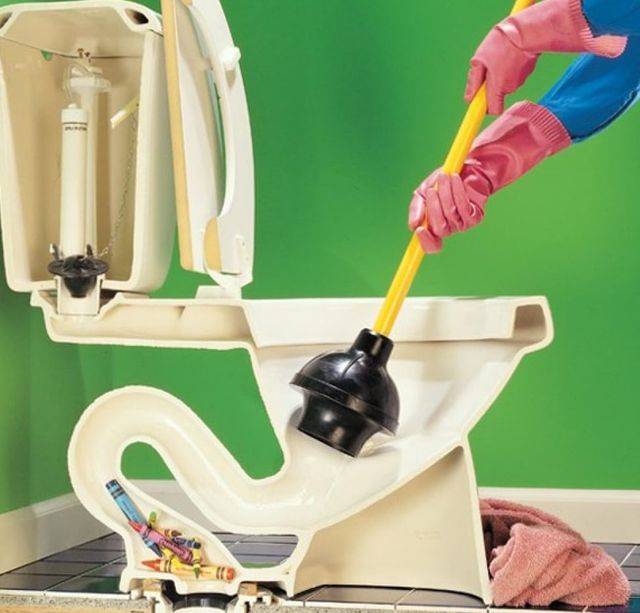
If the cause of the blockage is the accumulation of hair and small debris in the sewer pipes, chemical products from the store can help. These are "Mole" -type powders or liquid solutions containing acids. The chemical eats away at grease and debris, the plug is removed and the water leaves. For plastic pipes, such funds are not dangerous, but steel ones can corrode and burst.
Before using such chemicals, you should carefully read the instructions for use. Sometimes you have to wait several hours for the result. Therefore, if the water does not start to leave in the near future, you should not rush to conclusions and move on to radical methods of cleaning pipes. Perhaps the remedy will still work in a couple of hours.
Professional sewer cleaning method
The plumbing rope is a long flexible metal rope with a handle on one side and a sharp nozzle on the other.
The cable is immersed in the toilet and gently pushed into the interior. When the cable sinks about 1-1.5 meters, you need to simultaneously start to rotate it around its axis
It is convenient to carry out such manipulations together: one plunges the cable and pushes it, and the other rotates. The blockage will either be pushed deep into the sewer, or it will catch on with a tip and be pulled out of the pipe.
Live healthy! Unusual ways to clean the toilet. (20.06.2016)
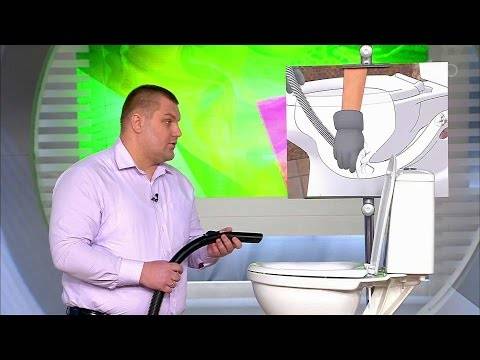
Coping with a toilet blockage is not so difficult if you act thoughtfully, calmly and consistently.You don't have to disturb the plumbers. But if, despite your actions, or after them, the water in the toilet begins to arrive before our eyes, you need to call the emergency service urgently. This means that there has been a serious blockage of the general drain, only a team of specialists can access hatches and openings and remove it.
Causes of clogging in the toilet
A properly functioning toilet is one of the basic conditions for a comfortable life. The toilet becomes clogged because foreign objects are thoughtlessly thrown into it:
- not crushed food waste, bones;
- old rags and sponges;
- plastic bags;
- hygiene products;
- too much toilet paper, newspapers.
Pet owners can dispose of litter trays down the drain. It adheres firmly to the pipes from the inside, reducing their permeability.
Frequent blockages are also possible with poor installation of the toilet, or the absence of a special valve, the function of which is to equalize the pressure in the sewer pipe.
Features of the sewer system in residential buildings
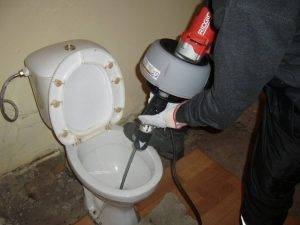 Why can plumbers very quickly remove the blockage and punch through the toilet, but it is not always possible to effectively cope with the problem on their own? Because professional locksmiths:
Why can plumbers very quickly remove the blockage and punch through the toilet, but it is not always possible to effectively cope with the problem on their own? Because professional locksmiths:
- have the necessary tools;
- perfectly understand how the sewage system is arranged in an apartment building.
Tools are not a problem - a plunger and a cable, as well as hot water and chemicals can be purchased if they are not available in your home pantry or garage. All these items will come in handy in one way or another, because the toilet bowl from time to time can get clogged even by the most careful owners, not always the reason for such a nuisance is in violation of the rules of operation. It remains only to understand the design features of the sewer system.
So, in a standard apartment there are usually at least three points for draining wastewater into a common sewer system:
- in the kitchen in the sink;
- in the toilet in the toilet;
- in the bathroom from the bath, washstand and shower.
Waste from each point first falls into a common riser, which passes through all floors, and then is discharged to the highway for the whole house. From there, waste water flows into the general city sewer system. To make it easier to clean the pipes in the event of a blockage, a separate additional hole is provided on each floor.
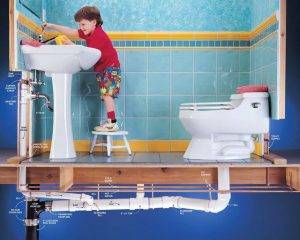 Although it must be said that if a large-scale blockage occurs, it still does not help much, the residents of all apartments that are located below the riser suffer.
Although it must be said that if a large-scale blockage occurs, it still does not help much, the residents of all apartments that are located below the riser suffer.
In this case, you cannot do without the services of professionals. If the blockage occurs within the apartment, you can handle it yourself. When the toilet in the apartment is clogged, what should be done at home first of all? True, to find the localization of the plug that clogged the drain pipes.
And also the reason for its occurrence. Without such diagnostics, it will take a very long time to look for an effective means for cleaning pipes - this is not only laborious, but also an unpleasant process.


